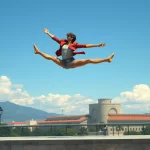Échappé: Escaping to the Next Position

Introduction
Échappé, a term derived from the French word meaning “escaped,” is a fundamental movement in ballet that involves a dancer moving from a closed position to an open position, typically from fifth position to second position, and then returning. This movement is not only a staple in classical ballet but also a critical component in various ballet routines and performances.
The importance of the Échappé in ballet cannot be overstated. It serves as a building block for more complex movements and helps dancers develop essential skills such as balance, coordination, and strength. Understanding and mastering the Échappé is crucial for any ballet dancer aiming to progress in their training and performance.
In this article, readers will learn about the historical background of the Échappé, a detailed technical breakdown of how to perform it, key elements of technique, common mistakes and how to avoid them, its applications in choreography, training exercises, and answers to frequently asked questions.
Historical Background
The origins of the Échappé can be traced back to the early days of ballet in the 17th century. Ballet itself began in the courts of Italy and France, and as it evolved, so did its movements and techniques. The Échappé was developed as a way to showcase a dancer’s ability to move gracefully and with precision from one position to another.
Over time, the Échappé has evolved and been refined by various choreographers and dancers. Notable figures in the history of ballet, such as Marius Petipa and George Balanchine, have incorporated the Échappé into their choreographies, further cementing its importance in the ballet repertoire.
Many renowned dancers, including Anna Pavlova and Rudolf Nureyev, have performed the Échappé with exceptional skill, inspiring generations of dancers to master this essential movement.
Technical Breakdown
Step-by-Step Explanation
Performing an Échappé involves several key steps:
- Begin in a closed position, typically fifth position, with your feet turned out and heels touching.
- Execute a small plié (bend your knees) to prepare for the jump.
- Push off the floor with both feet, extending your legs and pointing your toes as you jump.
- While in the air, open your legs to move into second position, with your feet landing slightly wider than shoulder-width apart.
- Land softly in a plié in second position, ensuring your knees are aligned with your toes.
- Push off the floor again, bringing your feet back together to return to fifth position.
- Land softly in a plié in fifth position, ready to repeat the movement if necessary.
Key Positions and Transitions
The key positions in an Échappé are the starting fifth position, the open second position, and the returning fifth position. The transitions between these positions involve precise timing and coordination to ensure a smooth and graceful movement.
Common Variations
There are several variations of the Échappé, including:
- Échappé Sauté: A jumping Échappé, as described above.
- Échappé Relevé: An Échappé performed on the balls of the feet or on pointe, without a jump.
- Échappé Battu: An Échappé with a beat of the legs before landing in second position.
Key Elements of Technique
Balance
Maintaining balance during an Échappé is crucial. Focus on keeping your core engaged and your weight evenly distributed between both feet. Practice balancing exercises, such as standing on one leg or using a balance board, to improve your stability.
Posture
Proper body alignment and positioning are essential for executing an Échappé correctly. Keep your shoulders down and back, your chest lifted, and your head aligned with your spine. Ensure your hips are level and your knees are aligned with your toes during pliés and landings.
Timing
Understanding the rhythm and timing of an Échappé is vital for a smooth execution. Practice with a metronome or to music with a clear beat to develop a sense of timing. Pay attention to the timing of your pliés, jumps, and landings to ensure they are synchronized.
Strength and Flexibility
The muscles involved in an Échappé include the quadriceps, hamstrings, calves, and core muscles. To develop the necessary strength and flexibility, incorporate exercises such as squats, lunges, calf raises, and core workouts into your training routine. Stretching exercises, such as hamstring and calf stretches, will also help improve your flexibility.
Common Mistakes and How to Avoid Them
Here are some frequent errors dancers make when performing an Échappé and tips to prevent them:
- Incorrect Foot Position: Ensure your feet are properly turned out in both fifth and second positions. Practice turnout exercises to improve your foot positioning.
- Insufficient Plié: A deep plié is essential for a powerful jump. Focus on bending your knees fully during the preparation and landing phases.
- Uneven Weight Distribution: Distribute your weight evenly between both feet to maintain balance. Practice balancing exercises to improve your stability.
- Improper Timing: Pay attention to the timing of your movements. Practice with a metronome or to music with a clear beat to develop a sense of rhythm.
- Weak Core Engagement: Engage your core muscles to maintain proper posture and balance. Incorporate core strengthening exercises into your training routine.
Applications in Choreography
The Échappé is a versatile movement that can be found in many famous ballets and routines. For example, it is prominently featured in “The Nutcracker,” “Swan Lake,” and “Giselle.” Choreographers use the Échappé to add dynamic transitions and showcase a dancer’s technical skills.
In different ballet styles, the Échappé can be adapted to fit the choreography. In classical ballet, it is often performed with a focus on precision and grace. In contemporary ballet, the movement may be executed with more fluidity and expression.
Training Exercises
Exercises and Drills
To master the Échappé, incorporate the following exercises and drills into your training routine:
- Plié Exercises: Practice deep pliés in both fifth and second positions to develop strength and flexibility in your legs.
- Jump Drills: Perform small jumps in place, focusing on proper foot positioning and timing.
- Balance Exercises: Practice balancing on one leg or using a balance board to improve stability.
- Turnout Exercises: Incorporate exercises that focus on improving your turnout, such as clamshells and frog stretches.
Conditioning Routines
Conditioning routines that support the required strength and flexibility for an Échappé include:
- Squats and Lunges: These exercises strengthen the quadriceps, hamstrings, and glutes.
- Calf Raises: Strengthen the calf muscles to improve your jumps and landings.
- Core Workouts: Incorporate exercises such as planks, Russian twists, and leg raises to strengthen your core muscles.
- Stretching Routines: Perform stretches for the hamstrings, calves, and hip flexors to improve flexibility.
FAQ
How long does it take to master Échappé?
The time it takes to master an Échappé varies depending on the dancer’s experience, dedication, and practice routine. For beginners, it may take several months of consistent practice to perform the movement with precision and grace. More experienced dancers may master it more quickly.
What are the most important muscles to strengthen for Échappé?
The most important muscles to strengthen for an Échappé are the quadriceps, hamstrings, calves, and core muscles. These muscles provide the power and stability needed for the jump and landing phases of the movement.
Can beginners attempt Échappé?
Yes, beginners can attempt an Échappé. It is a fundamental movement in ballet and is often taught in beginner classes. However, it is important for beginners to focus on proper technique and form to avoid injury and develop a strong foundation.
What are some common injuries associated with Échappé?
Common injuries associated with an Échappé include ankle sprains, knee injuries, and muscle strains. These injuries can often be prevented by focusing on proper technique, warming up before practice, and incorporating strength and flexibility exercises into your training routine.
How can I improve my technique for Échappé?
To improve your technique for an Échappé, focus on the following:
- Practice regularly and consistently.
- Work on your turnout and foot positioning.
- Incorporate strength and flexibility exercises into your training routine.
- Pay attention to your timing and rhythm.
- Seek feedback from instructors or experienced dancers.
Conclusion
In conclusion, the Échappé is a fundamental movement in ballet that plays a crucial role in a dancer’s training and performance. By understanding its historical background, mastering the technical breakdown, focusing on key elements of technique, avoiding common mistakes, and incorporating it into choreography, dancers can enhance their skills and artistry.
With consistent practice and dedication, dancers can refine their Échappé and use it as a stepping stone to more advanced movements. Remember to focus on proper technique, strength, and flexibility to achieve a graceful and precise Échappé.





